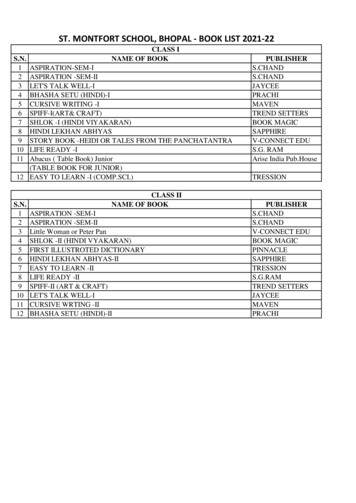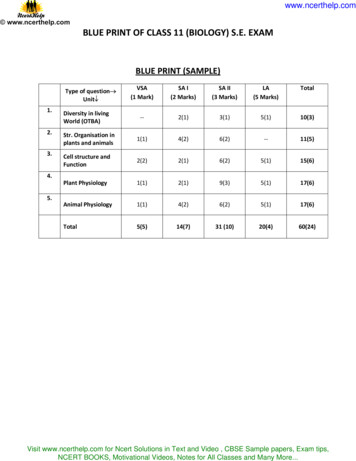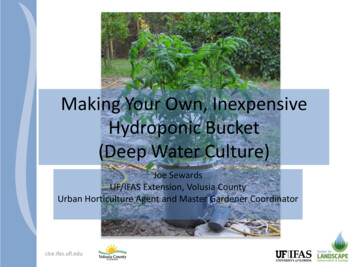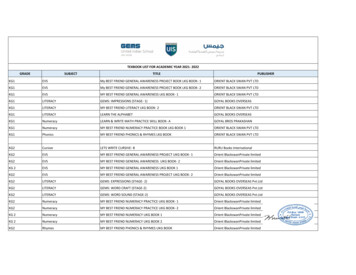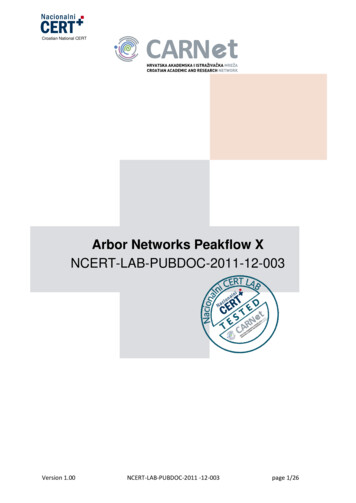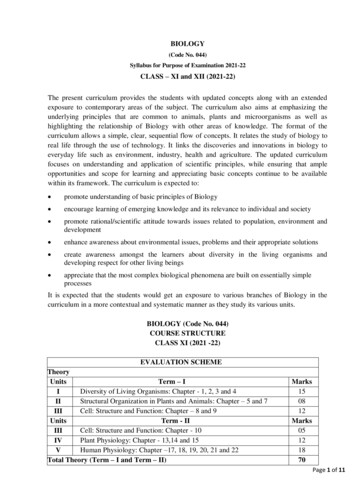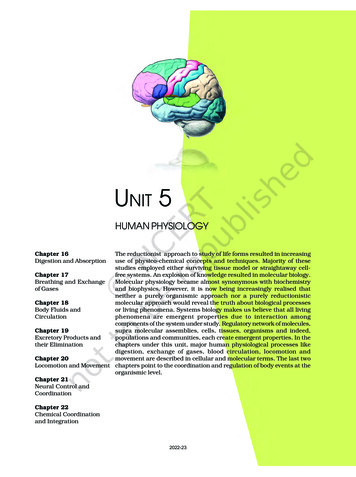
Transcription
UNIT 5HUMAN PHYSIOLOGYChapter 16Digestion and AbsorptionThe reductionist approach to study of life forms resulted in increasinguse of physico-chemical concepts and techniques. Majority of thesestudies employed either surviving tissue model or straightaway cellChapter 17free systems. An explosion of knowledge resulted in molecular biology.Breathing and ExchangeMolecular physiology became almost synonymous with biochemistryof Gasesand biophysics. However, it is now being increasingly realised thatneither a purely organismic approach nor a purely reductionisticChapter 18molecular approach would reveal the truth about biological processesBody Fluids andor living phenomena. Systems biology makes us believe that all livingCirculationphenomena are emergent properties due to interaction amongcomponents of the system under study. Regulatory network of molecules,Chapter 19supra molecular assemblies, cells, tissues, organisms and indeed,Excretory Products andpopulations and communities, each create emergent properties. In thetheir Eliminationchapters under this unit, major human physiological processes likedigestion, exchange of gases, blood circulation, locomotion andChapter 20movement are described in cellular and molecular terms. The last twoLocomotion and Movement chapters point to the coordination and regulation of body events at theorganismic level.Chapter 21Neural Control andCoordinationChapter 22Chemical Coordinationand Integration2022-23
ALFONSO CORTI, Italian anatomist, was born in 1822. Corti beganhis scientific career studying the cardiovascular systems ofreptiles. Later, he turned his attention to the mammalianauditory system. In 1851, he published a paper describing astructure located on the basilar membrane of the cochleacontaining hair cells that convert sound vibrations into nerveimpulses, the organ of Corti. He died in the year 1888.Alfonso Corti(1822 – 1888)2022-23
CHAPTER 16D IGESTION AND ABSORPTION16.1 DigestiveSystem16.2 Digestion ofFood16.3 Absorption ofDigestedProducts16.4 Disorders ofDigestiveSystemFood is one of the basic requirements of all living organisms. The majorcomponents of our food are carbohydrates, proteins and fats. Vitaminsand minerals are also required in small quantities. Food provides energyand organic materials for growth and repair of tissues. The water we takein, plays an important role in metabolic processes and also preventsdehydration of the body. Biomacromolecules in food cannot be utilisedby our body in their original form. They have to be broken down andconverted into simple substances in the digestive system. This process ofconversion of complex food substances to simple absorbable forms iscalled digestion and is carried out by our digestive system by mechanicaland biochemical methods. General organisation of the human digestivesystem is shown in Figure 16.1.16.1 D IGESTIVE SYSTEMThe human digestive system consists of the alimentary canal and theassociated glands.16.1.1 Alimentary CanalThe alimentary canal begins with an anterior opening – the mouth, and itopens out posteriorly through the anus. The mouth leads to the buccalcavity or oral cavity. The oral cavity has a number of teeth and a musculartongue. Each tooth is embedded in a socket of jaw bone (Figure16.2).This type of attachment is called thecodont. Majority of mammalsincluding human being forms two sets of teeth during their life, a set oftemporary milk or deciduous teeth replaced by a set of permanent oradult teeth. This type of dentition is called diphyodont. An adult human2022-23
258BIOLOGYSigmoid ColonFigure 16.1 The human digestive systemhas 32 permanent teeth which are of four different types (Heterodontdentition), namely, incisors (I), canine (C), premolars (PM) and molars(M). Arrangement of teeth in each half of the upper and lower jaw in theorder I, C, PM, M is represented by a dental formula which in human2123. The hard chewing surface of the teeth, made up of enamel, helps2123in the mastication of food. The tongue is a freely movable muscular organattached to the floor of the oral cavity by the frenulum. The upper surfaceof the tongue has small projections called papillae, some of which beartaste buds.The oral cavity leads into a short pharynx which serves as a commonpassage for food and air. The oesophagus and the trachea (wind pipe)open into the pharynx. A cartilaginous flap called epiglottis prevents theentry of food into the glottis – opening of the wind pipe – during swallowing.The oesophagus is a thin, long tube which extends posteriorly passingthrough the neck, thorax and diaphragm and leads to a ‘J’ shaped bagis2022-23
DIGESTION AND ABSORPTIONlike structure called stomach. A muscularsphincter (gastro-oesophageal) regulates theopening of oesophagus into the stomach.The stomach, located in the upper leftportion of the abdominal cavity, has fourmajor parts – a cardiac portion into whichthe oesophagus opens, a fundic region, body(main central region) and a pyloric portionwhich opens into the first part of smallintestine (Figure 16.3). Small intestine isdistinguishable into three regions, a ‘C’shaped duodenum, a long coiled middleportion jejunum and a highly coiled ileum.The opening of the stomach into theduodenum is guarded by the pyloricsphincter. Ileum opens into the largeintestine. It consists of caecum, colon andrectum. Caecum is a small blind sac whichhosts some symbiotic micro-organisms. Anarrow finger-like tubular projection, thevermiform appendix which is a vestigialorgan, arises from the caecum. The caecumopens into the colon. The colon is dividedinto four parts – an ascending, a transverse,descending part and a sigmoid colon. Thedescending part opens into the rectumwhich opens out through the anus.The wall of alimentary canal fromoesophagus to rectum possesses four layers(Figure 16.4) namely serosa, muscularis,sub-mucosa and mucosa. Serosa is theoutermost layer and is made up of a thinmesothelium (epithelium of visceral organs)with some connective tissues. Muscularis isformed by smooth muscles usuallyarranged into an inner circular and an outerlongitudinal layer. An oblique muscle layermay be present in some regions. The submucosal layer is formed of loose connectivetissues containing nerves, blood and lymphvessels. In duodenum, glands are alsopresent in sub-mucosa. The innermostlayer lining the lumen of the alimentarycanal is the mucosa. This layer formsirregular folds (rugae) in the stomach andsmall finger-like foldings called villi in thesmall intestine (Figure 16.5). The cells liningthe villi produce numerous microscopic259Figure 16.2Arrangement of different types ofteeth in the jaws on one side andthe sockets on the other sideFigure 16.3 Anatomical regions of humanstomach2022-23
260BIOLOGYFigure 16.4 Diagrammatic representation of transverse section of gutVilliLactealCapillariesArteryCryptsprojections called microvilli giving a brush borderappearance. These modifications increase thesurface area enormously. Villi are supplied witha network of capillaries and a large lymph vesselcalled the lacteal. Mucosal epithelium has gobletcells which secrete mucus that help in lubrication.Mucosa also forms glands in the stomach (gastricglands) and crypts in between the bases of villi inthe intestine (crypts of Lieberkuhn). All the fourlayers show modifications in different parts of thealimentary canal.16.1.2The digestive glands associated with thealimentary canal include the salivary glands, theliver and the pancreas.A section of small intestinalSaliva is mainly produced by three pairs ofmucosa showing villisalivary glands, the parotids (cheek), the submaxillary/sub-mandibular (lower jaw) and thesub- linguals (below the tongue). These glandssituated just outside the buccal cavity secretesalivary juice into the buccal cavity.Liver is the largest gland of the body weighing about 1.2 to 1.5 kg inan adult human. It is situated in the abdominal cavity, just below thediaphragm and has two lobes. The hepatic lobules are the structural andfunctional units of liver containing hepatic cells arranged in the form ofcords. Each lobule is covered by a thin connective tissue sheath calledthe Glisson’s capsule. The bile secreted by the hepatic cells passes throughthe hepatic ducts and is stored and concentrated in a thin muscular saccalled the gall bladder. The duct of gall bladder (cystic duct) along withVeinFigure 16.5Digestive Glands2022-23
DIGESTION AND ABSORPTION261the hepatic duct from the liver forms the common bile duct (Figure 16.6).The bile duct and the pancreatic duct open together into the duodenumas the common hepato-pancreatic duct which is guarded by a sphinctercalled the sphincter of Oddi.The pancreas is a compound (both exocrine and endocrine) elongatedorgan situated between the limbs of the ‘C’ shaped duodenum. Theexocrine portion secretes an alkaline pancreatic juice containing enzymesand the endocrine portion secretes hormones, insulin and glucagon.Figure 16.6 The duct systems of liver, gall bladder and pancreas16.2 DIGESTIONOFFOODThe process of digestion is accomplished by mechanical and chemicalprocesses.The buccal cavity performs two major functions, mastication of foodand facilitation of swallowing. The teeth and the tongue with the help ofsaliva masticate and mix up the food thoroughly. Mucus in saliva helpsin lubricating and adhering the masticated food particles into a bolus.The bolus is then conveyed into the pharynx and then into the oesophagusby swallowing or deglutition. The bolus further passes down throughthe oesophagus by successive waves of muscular contractions calledperistalsis. The gastro-oesophageal sphincter controls the passage of foodinto the stomach.The saliva secreted into the oral cavity containsand enzymes, salivary amylase andelectrolyteslysozyme. The chemical process of digestion is initiated in the oral cavityby the hydrolytic action of the carbohydrate splitting enzyme, the salivary2022-23
262BIOLOGYamylase. About 30 per cent of starch is hydrolysed here by this enzyme(optimum pH 6.8) into a disaccharide – maltose. Lysozyme present insaliva acts as an antibacterial agent that prevents infections.Salivary AmylaseStarch MaltosepH 6.8The mucosa of stomach has gastric glands. Gastric glands have threemajor types of cells namely (i) mucus neck cells which secrete mucus;(ii) peptic or chief cells which secrete the proenzyme pepsinogen; and(iii) parietal or oxyntic cells which secrete HCl and intrinsic factor(factor essential for absorption of vitamin B12).The stomach stores the food for 4-5 hours. The food mixes thoroughlywith the acidic gastric juice of the stomach by the churning movementsof its muscular wall and is called the chyme. The proenzyme pepsinogen,on exposure to hydrochloric acid gets converted into the active enzymepepsin, the proteolytic enzyme of the stomach. Pepsin converts proteinsinto proteoses and peptones (peptides). The mucus and bicarbonatespresent in the gastric juice play an important role in lubrication andprotection of the mucosal epithelium from excoriation by the highlyconcentrated hydrochloric acid. HCl provides the acidic pH (pH 1.8)optimal for pepsins. Rennin is a proteolytic enzyme found in gastric juiceof infants which helps in the digestion of milk proteins. Small amounts oflipases are also secreted by gastric glands.Various types of movements are generated by the muscularis layer ofthe small intestine. These movements help in a thorough mixing up ofthe food with various secretions in the intestine and thereby facilitatedigestion. The bile, pancreatic juice and the intestinal juice are thesecretions released into the small intestine. Pancreatic juice and bile arereleased through the hepato-pancreatic duct. The pancreatic juicecontains inactive enzymes – trypsinogen, chymotrypsinogen,procarboxypeptidases, amylases, lipases and nucleases. Trypsinogen isactivated by an enzyme, enterokinase, secreted by the intestinal mucosainto active trypsin, which in turn activates the other enzymes in thepancreatic juice. The bile released into the duodenum contains bilepigments (bilirubin and bili-verdin), bile salts, cholesterol andphospholipids but no enzymes. Bile helps in emulsification of fats, i.e.,breaking down of the fats into very small micelles. Bile also activates lipases.The intestinal mucosal epithelium has goblet cells which secretemucus. The secretions of the brush border cells of the mucosa alongwiththe secretions of the goblet cells constitute the intestinal juice orsuccus entericus. This juice contains a variety of enzymes likedisaccharidases (e.g., maltase), dipeptidases, lipases, nucleosidases, etc.The mucus alongwith the bicarbonates from the pancreas protects theintestinal mucosa from acid as well as provide an alkaline medium (pH7.8) for enzymatic activities. Sub-mucosal glands (Brunner’s glands) alsohelp in this.2022-23
DIGESTION AND ABSORPTION263Proteins, proteoses and peptones (partially hydrolysed proteins) inthe chyme reaching the intestine are acted upon by the proteolyticenzymes of pancreatic juice as given below:Proteins Trypsin/Chymotrypsin Peptones DipeptidesCarboxypeptidaseProteoses Carbohydrates in the chyme are hydrolysed by pancreatic amylaseinto disaccharides.AmylasePolysaccharides (starch ) DisaccharidesFats are broken down by lipases with the help of bile into di-andmonoglycerides.LipasesFats Diglycerides MonoglyceridesNucleases in the pancreatic juice acts on nucleic acids to formnucleotides and nucleosidesNucleases Nucleotides NucleosidesNucleic acids The enzymes in the succus entericus act on the end products of theabove reactions to form the respective simple absorbable forms. Thesefinal steps in digestion occur very close to the mucosal epithelial cells ofthe intestine.DipeptidasesDipeptides Amino acidsMaltaseMaltose Glucose GlucoseLactaseLactose Glucose GalactoseSucraseSucrose Glucose FructoseNucleotidasesNucleosidasesNucleotides Nucleosides Sugars BasesLipasesDi and Monoglycerides Fatty acids GlycerolThe breakdown of biomacromolecules mentioned above occurs in theduodenum region of the small intestine. The simple substances thusformed are absorbed in the jejunum and ileum regions of the smallintestine. The undigested and unabsorbed substances are passed on tothe large intestine.2022-23
264BIOLOGYNo significant digestive activity occurs in the large intestine. Thefunctions of large intestine are:(i) absorption of some water, minerals and certain drugs;(ii) secretion of mucus which helps in adhering the waste (undigested)particles together and lubricating it for an easy passage.The undigested, unabsorbed substances called faeces enters into the caecumof the large intestine through ileo-caecal valve, which prevents the back flow ofthe faecal matter. It is temporarily stored in the rectum till defaecation.The activities of the gastro-intestinal tract are under neural andhormonal control for proper coordination of different parts. The sight, smelland/or the presence of food in the oral cavity can stimulate the secretion ofsaliva. Gastric and intestinal secretions are also, similarly, stimulated byneural signals. The muscular activities of different parts of the alimentarycanal can also be moderated by neural mechanisms, both local and throughCNS. Hormonal control of the secretion of digestive juices is carried out bylocal hormones produced by the gastric and intestinal mucosa.CALORIFIC VALUE OF PROTEIN, CARBOHYDRATE(Boxed item – Not for evaluation)ANDFATThe energy requirements of animals, and the energy content of food, areexpressed in terms of measure of heat energy because heat is the ultimate formof all energies. This is often measured to as calorie (cal) or joule (J), which is theamount of heat energy required to raise the temperature of 1 g of water by 1 C.Since this value is tiny amount of energy, physiologists commonly use kilocalorie(kcal) or kilo joule (kJ). One kilo calorie is the amount of energy required to raisethe temperature of 1 kg of water by 1 C. Nutritionists, traditionally refer to kcalas the Calorie or Joule (always capitalised). The amount of heat liberated fromcomplete combustion of 1 g food in a bomb calorimeter (a closed metal chamberfilled with O2) is its gross calorific or gross energy value. The actual amount ofenergy combustion of 1 g of food is the physiologic value of food. Gross calorificvalues of carbohydrates, proteins and fats are 4.1 kcal/g, 5.65 kcal/g and 9.45kcal/g, respectively, whereas their physiologic values are 4.0 kcal/g, 4.0 kcal/gand 9.0 kcal/g, respectively.16.3 ABSORPTION OF DIGESTED PRODUCTSAbsorption is the process by which the end products of digestion passthrough the intestinal mucosa into the blood or lymph. It is carried out bypassive, active or facilitated transport mechanisms. Small amounts ofmonosaccharides like glucose, amino acids and some electrolytes likechloride ions are generally absorbed by simple diffusion. The passage ofthese substances into the blood depends upon the concentration gradients.However, some substances like glucose and amino acids are absorbed withthe help of carrier proteins. This mechanism is called the facilitated transport.Transport of water depends upon the osmotic gradient. Activetransport occurs against the concentration gradient and hence requiresenergy. Various nutrients like amino acids, monosaccharides like glucose,electrolytes like Na are absorbed into the blood by this mechanism.Fatty acids and glycerol being insoluble, cannot be absorbed into the2022-23
DIGESTION AND ABSORPTION265blood. They are first incorporated into small droplets called micelles whichmove into the intestinal mucosa. They are re-formed into very small proteincoated fat globules called the chylomicrons which are transported intothe lymph vessels (lacteals) in the villi. These lymph vessels ultimatelyrelease the absorbed substances into the blood stream.Absorption of substances takes place in different parts of the alimentarycanal, like mouth, stomach, small intestine and large intestine. However,maximum absorption occurs in the small intestine. A summary of absorption(sites of absorption and substances absorbed) is given in Table 16.1.TABLE 16.1 The Summary of Absorption in Different Parts of Digestive SystemMouthStomachSmall IntestineLarge IntestineCertain drugscoming in contactwith the mucosaof mouth andlower side of thetongue areabsorbed into theblood capillarieslining them.Absorption ofwater, simplesugars, andalcohol etc.takes place.Principal organ for absorptionof nutrients. The digestion iscompleted here and the finalproducts of digestion such asglucose, fructose, fatty acids,glycerol and amino acids areabsorbed through the mucosainto the blood stream andlymph.Absorption ofwater, someminerals anddrugs takesplace.The absorbed substances finally reach the tissues which utilise themfor their activities. This process is called assimilation.The digestive wastes, solidified into coherent faeces in the rectuminitiate a neural reflex causing an urge or desire for its removal. Theegestion of faeces to the outside through the anal opening (defaecation) isa voluntary process and is carried out by a mass peristaltic movement.16.4 DISORDERS OF DIGESTIVE SYSTEMThe inflammation of the intestinal tract is the most common ailment dueto bacterial or viral infections. The infections are also caused by theparasites of the intestine like tapeworm, roundworm, threadworm,hookworm, pin worm, etc.Jaundice: The liver is affected, skin and eyes turn yellow due to thedeposit of bile pigments.Vomiting: It is the ejection of stomach contents through the mouth. Thisreflex action is controlled by the vomit centre in the medulla. A feeling ofnausea precedes vomiting.Diarrhoea: The abnormal frequency of bowel movement and increasedliquidity of the faecal discharge is known as diarrhoea. It reduces theabsorption of food.Constipation: In constipation, the faeces are retained within the colonas the bowel movements occur irregularly.Indigestion: In this condition, the food is not properly digested leading toa feeling of fullness. The causes of indigestion are inadequate enzymesecretion, anxiety, food poisoning, over eating, and spicy food.2022-23
266BIOLOGYPEMDietary deficiencies of proteins and total food calories are widespread inmany underdeveloped countries of South and South-east Asia, SouthAmerica, and West and Central Africa. Protein-energy malnutrition(PEM) may affect large sections of the population during drought, famineand political turmoil. This happened in Bangladesh during the liberationwar and in Ethiopia during the severe drought in mid-eighties. PEM affectsinfants and children to produce Marasmus and Kwashiorkar.Marasmus is produced by a simultaneous deficiency of proteins andcalories. It is found in infants less than a year in age, if mother’s milk isreplaced too early by other foods which are poor in both proteins andcaloric value. This often happens if the mother has second pregnancy orchildbirth when the older infant is still too young. In Marasmus, proteindeficiency impairs growth and replacement of tissue proteins; extremeemaciation of the body and thinning of limbs results, the skin becomesdry, thin and wrinkled. Growth rate and body weight decline considerably.Even growth and development of brain and mental faculties are impaired.Kwashiorkar is produced by protein deficiency unaccompanied by caloriedeficiency. It results from the replacement of mother’s milk by a high calorielow protein diet in a child more than one year in age. Like marasmus,kwashiorkor shows wasting of muscles, thinning of limbs, failure of growthand brain development. But unlike marasmus, some fat is still left underthe skin; moreover, extensive oedema and swelling of body parts are seen.SUMMARYThe digestive system of humans consists of an alimentary canal andassociated digestive glands. The alimentary canal consists of the mouth,buccal cavity, pharynx, oesophagus, stomach, small intestine, largeintestine, rectum and the anus. The accessory digestive glands include thesalivary glands, the liver (with gall bladder) and the pancreas. Inside themouth the teeth masticates the food, the tongue tastes the food andmanipulates it for proper mastication by mixing with the saliva. Salivacontains a starch digestive enzyme, salivary amylase that digests the starchand converts it into maltose (disaccharide). The food then passes into thepharynx and enters the oesophagus in the form of bolus, which is furthercarried down through the oesophagus by peristalsis into the stomach. Instomach mainly protein digestion takes place. Absorption of simple sugars,alcohol and medicines also takes place in the stomach.The chyme (food) enters into the duodenum portion of the smallintestine and is acted on by the pancreatic juice, bile and finally by theenzymes in the succus entericus, so that the digestion of carbohydrates,proteins and fats is completed. The food then enters into the jejunum andileum portions of the small intestine. Carbohydrates are digested andconverted into monosaccharides like glucose. Proteins are finally brokendown into amino acids. The fats are converted to fatty acids and glycerol.2022-23
DIGESTION AND ABSORPTION267The digested end products are absorbed into the body through the epithelial liningof the intestinal villi. The undigested food (faeces) enters into the caecum of the largeintestine through ileo-caecal valve, which prevents the back flow of the faecal matter.Most of the water is absorbed in the large intestine. The undigested food becomessemi-solid in nature and then enters into the rectum, anal canal and is finally egestedout through the anus.EXERCISES1.Choose the correct answer among the following :(a) Gastric juice contains(i) pepsin, lipase and rennin(ii) trypsin, lipase and rennin(iii) trypsin, pepsin and lipase(iv) trypsin, pepsin and renin(b) Succus entericus is the name given to(i) a junction between ileum and large intestine(ii) intestinal juice(iii) swelling in the gut(iv) appendix2.Match column I with column IIColumn I(a) Bilirubin and biliverdin(b) Hydrolysis of starch(c) Digestion of fat(d) Salivary gland3.4.5.6.7.8.9.10.11.12.13.14.15.Column II(i) Parotid(ii) Bile(iii) Lipases(iv) AmylasesAnswer briefly:(a) Why are villi present in the intestine and not in the stomach?(b) How does pepsinogen change into its active form?(c) What are the basic layers of the wall of alimentary canal?(d) How does bile help in the digestion of fats?State the role of pancreatic juice in digestion of proteins.Describe the process of digestion of protein in stomach.Give the dental formula of human beings.Bile juice contains no digestive enzymes, yet it is important for digestion. Why?Describe the digestive role of chymotrypsin. Which two other digestive enzymesof the same category are secreted by its source gland?How are polysaccharides and disaccharides digested?What would happen if HCl were not secreted in the stomach?How does butter in your food get digested and absorbed in the body?Discuss the main steps in the digestion of proteins as the food passes throughdifferent parts of the alimentary canal.Explain the term thecodont and diphyodont.Name different types of teeth and their number in an adult human.What are the functions of liver?2022-23
including human being forms two sets of teeth during their life, a set of temporary milk or deciduous teeth replaced by a set of permanent or adult teeth. This type of dentition is called diphyodont . An adult human DIGESTION AND ABSORPTION C HAPTER 16 16.1 Digestive System 16.2 Digestion of Food 16.3 Absorption of Digested Products 16.4 .
